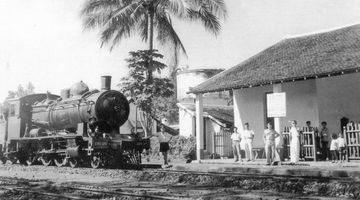Top-20 meest interessante, ongebruikelijke en leuke feiten over Laos
Ahhh, the lovely landlocked, little country called Laos. Fairly unknown by tourists, backpackers and travellers for many years, this fascinating country is starting to make its way onto the bucket lists of many wanderlusters due to its largely untouched natural beauty, vibrant culture and intriguing history and traditions. What many travel guides fail to mention however is that Laos is home to many funny things, odd, unusual facts and quirky peculiarities that somehow go unmentioned. Strange, entertaining and downright bizarre, we are here to spill the beans on good ol’ Laos.
Okay, here we go! 20 interesting facts about Laos.
1. The Laotians consume more sticky rice than anyone else in the world
The versatile national staple, sticky rice, is consumed in Laos more than anywhere else on planet earth. Eaten traditionally with their hands, served sweet, fermented or sour, 155 kilograms of this national dish is consumed per Laotian every year. By contrast, the average European or American consumes only around 9 kilograms of rice per annum. In fact, Laotians commonly refer to themselves as “luk khao niaow” which aptly translates to “children or descendants of sticky rice”. Seems appropriate.
2. Laos is the most bombed place in the world
This devastating fact is a result of the United States bombings on Laos during the Vietnam War where for nine years, from 1964 to 1973, the US dropped more than two million tons of bombs across Laos. 30% of these bombs didn’t explode, resulting in most of Laos’ land being unfeasible for agriculture. Still today hundreds of Laotians are injured or killed as a result of bombs and grenades that get accidentally discovered.
3. Zero ocean but thousands of islands
Although Laos is a completely landlocked country, in the south of the country lies one of the most incredible natural attractions en route of the powerful Mekong River – Si Phan Don. Si Phan Don is more commonly known as The 4000 Islands. These spectacular islands abound with powdery shores and turquoise waves meaning that a tropical beach holiday in Laos is an excellent choice for beach bums. Extending 4350 kilometres, the Mekong River has divided the land of Laos into thousands of exquisite islets.
4. Home to a magical ‘crater’ lake
Nong Fa Lake – a stunning volcanic lake found at elevated levels in the mountains of southeast Laos, is shrouded in legends, respect and fear. The Laotians refuse to swim or bathe in the waters as they believe that the lake is home to a giant snake-pig that will consume any who dare to wade into its depths. Translated directly to ‘sky lake’, Nong Fa is assumed to be around 78 meters deep although locals cannot be sure as attempts to measure the depths with bamboo poles have proven to be unsuccessful.
5. The Vieng Xai Caves once concealed an entire city
Just over 50 years ago, nestled deep in thick jungles and between limestone cliffs, the Vieng Xai Caves were once home to over 20 thousand Laotians who hid from American bombs during the Vietnam War for more than a decade. This elaborate network of over 450 limestone caves commonly known as ‘The City of Victory’ was founded by Kaysone Phomvihane, head of the Laos communist movement. The secret caves were made up of homes, schools, markets, a bakery, a bank, a theatre, an elephant enclosure and even hospitals for its inhabitants. Today the caves are a museum enthralling all who visit.
6. Home to a surprising abundance of wildlife
The lush jungles of Laos are home to a stunning abundance of wildlife and this country is the breeding grounds for King Cobras, white-cheeked gibbons, tigers, Asian black bears. Other wild animals include sambar deer, sun bears, leopards and leopard cats. Night safaris at the biodiverse Nam Et-Phou Louey National Biodiversity Conservation Area (NBCA) offer visitors the chance to spot some of the shyer, nocturnal animals.
7. The 4-day Thakhek Loop motorbike journey
For those who long for the open road, the 4-day Thakhek Loop, commonly known by bikers as “The Loop”, is a truly spectacular 440-kilometer journey through Thalang and Kong Lor Cave. The 4-day bike or scooter ride will take you through jaw-dropping scenery, such as, glistening rice paddies, looming limestone cliffs, rural villages, cascading waterfalls and stunning caves. A must-do for all adventurers travelling through Laos.
8. Coffee is Laos’ biggest agricultural export
Tea in Sri Lanka is what coffee is to Laos. Lattes, espressos, cappuccinos – the Arabica coffee bean leads the way in Laos and is the country’s biggest farming export. The coffee crops continue to grow and expand across the country each year and the high quality beans are in much demand with the overseas market. Hooray for all things caffeinated!
9. Home to possibly the cheapest alcohol in the world
Lao-Lao is a potent rice-whiskey made in Laos that sells for less than a dollar per litre! Easily located in any corner store, mom-and-pop shop, or market across the country, the spirit is the cheapest in the world. Before you get too excited however, the ridiculously low price comes with ramifications of its own. It tastes akin to downing a bottle of Methylated Spirits, has caused blindness in very rare cases and is a sure-fire bet that you won’t remember the details of the night before. Errr, this is all hearsay of course. Consider yourself warned.
10. “Simply beautiful” is the official Laos tourism slogan
With its breath-taking scenery, fascinating history and welcoming, friendly locals it’s easy to see why Laos was named World’s Best Tourist Destination by the European Council on Tourism and Trade in 2013. The country received a record 3.1 million foreign visitors in 2012, which is equal to half of Laos’ population, and was then given ‘Simply Beautiful’ as the official tourism slogan. We couldn’t agree with the slogan more.
11. Laos is the only landlocked country in the whole of Southeast Asia
Recently referred to as ‘land-linked’ rather than ‘land-locked’, Laos is an independent republic in Southeast Asia bordered by northeast Thailand, west Vietnam and is surrounded by Myanmar, Cambodia, China, Thailand and Vietnam. Historically being land-locked has been considered to be a disadvantage as countries are cut off from sea trade, fishing and international importing and exporting. The Lao government, however, has recently been advocating the perception that Laos is a land bridge which can offer the most direct land transport routes between its neighbours.
12. The Plain of Jars
Home to a very mysterious and puzzling pottery site on the Xiangkhoang Plateau known as The Plain of Jars. The landscape is strewn with thousands of stone jars and no one knows for sure what they were used for but they date all the way back to the Stone Age (500 BC – AD 500). The curious sight has allowed for a great deal of opinions, theories and stories. Some say the jars are a part of local burial ceremonies, others say that the jars once contained whiskey for thirsty giants who lived in the nearby mountains. Go take a look and decide for yourself.
13. The oldest modern human fossil in Southeast Asia was found in Laos
An ancient skull was discovered in the Tam PaLing Cave in the Annamite Mountains in the north of Laos as well as an even older jawbone which is at least 46, 000 years old. The discovery provided substantial evidence that ancient hominids wandered down inland riverbeds, rather than only migrating from African coastlines as originally assumed. The discovery also suggests that ancient people from Africa inhabited varied habitats far earlier than previously believed.
14. The Mekong River – more than just a river
The longest river in Southeast Asia, the mighty Mekong River instils life into the country of Laos. Not only does the river offer viable forms of transportation for people, trade goods, imports and exports; but it also assists with generating electricity, irrigating agricultural crops as well as making fishing an option for a land-locked country such as Laos. Known as ‘Mae Nam Khong’ by the locals, the Mekong River can be directly translated to ‘Mother of all rivers’.
15. Rhinoceros-beetle wrestling
That’s right, you read that correctly. Laos is home to one of the strangest competitive betting sports – rhinoceros beetle wrestling. The first beetle to severely maim, injure or kill its opponent beetle, is the victorious winner. People bet on which beetle they think is most likely to win and in this way rhinoceros beetle wrestling is an enthusiastic and competitive pastime of the locals.
16. Home to the largest waterfall in Southeast Asia
The Khone Phapheng waterfall, known also as ‘The Niagara of the east’, is located on the Mekong River in southern Laos and is the largest waterfall in Southeast Asia with the highest point being 21 meters. The rapids stretch almost 10 kilometres down the length of the Mekong River. This waterfall is the main reason that the Mekong River is not completely navigable into China despite the many failed efforts of the French colonists in the 19th century.
17. Laos is the home of 60 ‘Smiling’ Irrawaddy dolphins
The Irrawaddy dolphins with their rounded noses and adorable upturned mouths have become fondly known as ‘The smiling faces of the Mekong’. These beautiful creatures have sadly been dwindling drastically in numbers and are critically endangered as a result of pollution and electrofishing. Today only 60 are thought to remain in the Mekong and pretty soon these extraordinary mammals might well be extinct in Laos. A rare and special sighting, conservation efforts are presently underway to protect and save these local dolphins.
18. Laos is a fascinating ethnic melting pot of cultures
Although Laos is made up of slightly more than 50% ethnic Lao (Lao Lum), there are over 60 other diverse ethnic groups living within the borders of the land-locked country. The native people of Lao are characterised by altitude with 50% of Laotians being lowland people living nearby and around the Mekong River; 20% reside in the midlands and highlands; and 15% dwell 1,000 meters above sea level. The outstanding 15% are Thai. This melting pot of diverse culture, traditions and customs are just one of the reasons that Laos is such a fascinating ethnic tapestry filled with rich history.
19. The ‘Land of a million elephants’
Despite declining numbers, the wild elephant is considered to be one of Laos’ national symbols and used to be called, ‘Lane Xang’ which translates into, “The Land of a Million Elephants”. King Fa Ngum named it this in 1354 as his kingdom (Luang Prabang today) was surrounded by massive grazing pastures where wild elephants lived.
20. 100% hand woven silk
Setting itself apart from its neighboring countries’ silk products and intricate weaves, Lao silk products are completely and solely woven by hand. The specifics of the weaving process vary from family to family as do the designs and patterns. This means that each silk-woven item is truly unique and all the more special. While the average rate of production for Laotian silk goods is roughly a meter a day, some of the more intricate and extravagant weaves are only a couple of centimeters.




























